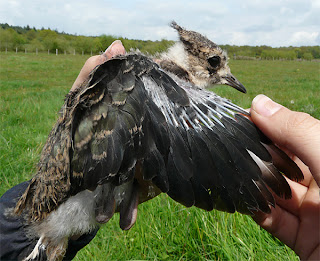It has been a while since my last post due to two reasons, firstly I have been away guiding an Ornitholidays bird watching trip to Turkey, and secondly, since I have been back I have been snowed under with work. But this weekend I finally got the chance to get out and do some of the things that I like to do.
My weekend began with a visit to a local site that supports a few pairs of breeding Lapwing. I have seen a few good sized Lapwing chicks during the course of my work recently, and so armed with my ringing kit, binoculars and a very enthusiastic trainee we set off. On arriving at the site it was obvious that things might be a bit harder than usual, since there were very few livestock grazing, and subsequently the vegetation was much higher than usual. Nonetheless, we persevered and soon found three pairs of Lapwing, widely spread out across the field. They say that patience is a virtue, and it was certainly required for this task, as we settled ourselves down to watch the field. The first chick we saw was right at the back of the field and as I walked towards it, it vanished over the hill from view.
The second chick though was much easier. As I walked towards it the parents uttered a short sharp alarm call and it sat tight, but I had a fix on its location. As I stealthily approached I could see it sat tight in the grass and just walked up and picked it up.
 |
| Juvenile Lapwing |
This chick was a good size, weighing in at a healthy 145 grams.......
 |
| Juvenile Lapwing |
........and looking at the length of its primary feathers, and the extent of feather protruding from the sheath, it won't be long before this bird is on the wing. There must have been at least 30 corvids feeding in the same field, so you have to give credit to the parents for managing to raise a young bird in a field with so many potential predators.
 |
| Juvenile Lapwing |
After processing this bird we carried on searching for a while, but were on a bit of a tight deadline so unfortunately had to leave. Our next site was Hook Barn, to check up on the Brown Long-eared Bat colony. As many will be aware, this spring has been an odd one weather wise, so we were intrigued to see what the bats were doing. As we entered the barn and looked up, four bats were immediately visible, and after a few minutes looking around we had found 10 Brown Long-eared Bats.
 |
| Brown Long-eared Bat |
But interestingly we also found four Common Pipistrelles, and a bat of the Myotis genus, which was tucked away right up in the apex. The pipistrelle bats have usually left the barn by now and returned to their maternity roosts, guess the weather must be affecting them. It was difficult to get a view of the Myotis bat, but one thing we could see was its large and hairy feet, suggesting that it was a Daubenton's Bat. We have not recorded this species previously in the barn, so we will have to try and either get a better view or leave a remote bat detector in the barn for a while and record its calls, lets hope it stays around.
No comments:
Post a Comment